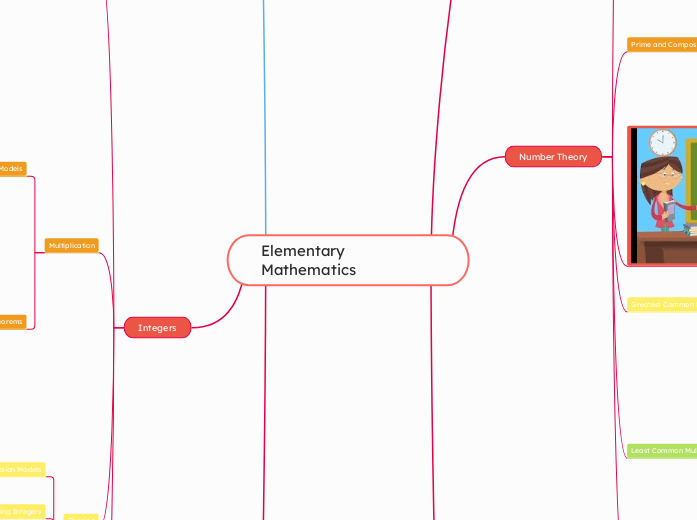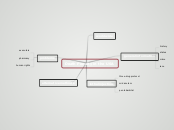Elementary Mathematics
Decimals, Percents, and Real Number
Real Numbers
any number that can be represented by a decimal
Irrational Numbers
cannot be a repeating block of digits
infinite number of non-zero digits to the right of the decimal point
Percents
Computing Interest
A=P+I=P+Prt=P(1+rt)
amount (a), principal (p), interest (i)
Mental Math
using a known percent
using fraction equivalents
Proportions
Percent Bar
n%=n/100
Decimals
Repeating Decimals
Balancing with Decimals in Division
Balancing with Decimals in Subtraction
Making Compatible Numbers
Breaking and Bridging
Division
Scientific Notation
Terminating Decimals
Ordering Terminating Decimals
Compare the digits, the digit with the greater face value represents the greater of the numbers
2. Start at the left and find the first place where the values are different
1. Line up the numbers by place value
Theorem
a/b is simplest form can be written as a termination decimal if prime factorization of the denominator contains no primes other than 2 or 5
numbers that can be written with a finite number of digits to the right of the decimal point
Integers
if xny
if x0 then nx
if x-y
if x
Ordering Integers
-3>-5
-5<-3
Difference of Squares
(a+b)(a-b)=a^2-b^2
Distributive Property of Multiplication Over Subtraction of Integers
(b-c)a=ba-ca
a(b-c)-ab-ac
(-a)(-b)=ab
(-a)b=-(ab)
(-1)a=-a
Zero Property
a(0)=0=0(a)
Distributive Property of Multiplication Over Addition for Integers
Identity Property
1(a)=a=a(1)
Associative Property
(ab)c=a(bc)
Commutative Property
ab=ba
Closure Property
ab is a unique integer
Integer Multiplication Models
Pattern Model
Addition and Subtraction
Additive Inverse Property of Integers
a+-a=0=-a+a
-a+-b=-(a+b)
Addition Property of Equality for Integers
if a=b, a+c=b+c
-(-a)=a
Identity Property of Addition of Integers
0+a=a=a+0
Associative Property of Addition of Integers
Commutative Property of Addition of Integers
Closure Property of Addition of Integers
a+b is a unique integer
Representation of Integers
Temperature Cube Model
Charged Field
Number Line Model
Chip Model
Absolute Value
distance between the point corresponding to an integer and 0
Positive Integers
1, 2, 3, 4...
Negative Integers
-1, -2, -3, -4...
Whole Number Operations
Division of Whole Numbers
Breaking Up the Dividend
Division by 0 and 1
division by 0 is undefined
n/0= undefined, 0/n= 0, 0/0= undefined, n/1= 1
Division Models
Missing Factor Model
3c=18, 3 x 6=18, c=6
Repeated Subtraction
10-2=8,8-2=6,6-2=4,4-2=2,2-2=0 (five groups of 2 in 10)
Multiplication of Whole Numbers
Compatible Numbers
524 x 8= 500 x 8=4000 and 25 x 8=200 = 4200
Front-End Multiplying
524 x 8= 500 x 8= 4000 and 20 x 8= 160 = 4000+160=4160
Thinking Money
Using Compatible Numbers
Front-End Multiplying
64 x 5= 60 x 5=300 and 4 x 5=20= 300+20=320
Alternative Methods
Lattice Multiplication
Partial Products Algorithm
Distributive Property of Multiplication Over Subtraction for Whole Numbers
a(b-c)=ab-ac
Distributive Property of Multiplication Over Addition of for Whole Numbers
a(b+c)=ab+ac
Multiplication Property of 0 for Whole Numbers
a x 0=0=0 x a
Identity Property of Multiplication of Whole Numbers
a x 1= a =1 x a
Associative Property of Multiplication of Whole Numbers
(a x b) x c= a x (b x c)
Commutative Property of Multiplication of Whole Numbers
a x b = b x a
Closure Property of Multiplication of Whole Numbers
a x b is a unique whole number
Multiplication Models
Cartesion-Product Model
the number of ways objects in sets can be combined
tree diagram or table
Area Model
4-by-5 grid
Rectangular Array Model
objects arranged with the same number of objects in each row and column
8+8+8=24
Subtraction of Whole Numbers
drop the zeros
subtraction models
base ten blocks
comparison model
missing addend model
number line
take-away model
operations that undo each other are inverse operations
subtraction is inverse of addition
Addition of Whole Numbers
using the range
rounding
clustering
grouping to nice numbers
front-end with adjustment
Mental Computation
making compatible numbers
using compatible numbers
sums easy to calculate mentally
trading off
breaking up and bridging
adding from left
Identity Property of Addition of Whole Numbers
a+0=a
Associative Property of Addition of Whole Numbers
(a+b)+c=a+(b+c)
Commutative Property of Addition of Whole Numbers
a+b=b+a
Closure Property of Addition of Whole Numbers
sum of two whole numbers is a unique whole number
Basic Addition Facts
making ten
doubles
counting on
shown using set model and number line
two disjoint finite sets
binary operation because two numbers are added
Rational Numbers and Proportional Reasoning
Proportional Reasoning
Bar Models
Scale Drawings
Constant of Proportionality
a/b=c/d if a/c=b/d
a/b=c/d if b/a=d/c
if y=kx (or k=y/x) then y is proportional to x and k is the constant of proportionality between y and x
Proportion
a/b=c/d is a proportion if ad=bc
two given ratios are equal
Ratio
A comparison of two quantities
a/b, a:b
Division
Properties of Exponents
Algorithm for Division of Fractions
(a/b)/(c/d)=(a/b)(d/c)
Multiplication
Repeated Addition
Theorems
Multiplication Property of Zero for Rational Numbers
(a/b) 0=0=0 (a/b)
Multiplication Properties of Inequalities for Rational Numbers
If a/b>c/d and e/f<0, then (a/b)(e/f)<(c/d)(e/f)
If a/b>c/d and e/f>0, then (a/b)(e/f)>(c/d)(e/f)
Multiplication Property of Equality for Rational Numbers
(a/b)(e/f)=(c/d)(e/f)
Distributive Properties of Multiplication Over Addition and Subtraction for Rational Numbers
a/b(c/d+e/f)=(a/b)(c/d)+(a/b)(e/f) and a/b(c/d+e/f)=(a/b)(c/d)-(a/b)(e/f)
Multiplicative Inverse Property of Rational Numbers
(a/b)(b/a)=1=(b/a)(a/b)
Multiplicative Identity Property of Rational Numbers
1 (a/b)=a/b=(a/b) 1
Subtopic
Estimation
round fractions to a convenient fraction
1/2,1/3,1/4,2/3, or 1
Subtraction
Addition
Addition Property of Equality
If a/b=c/d, then a/b+e/f=c/d+e/f
Additive Inverse Property of Rational Numbers
a/b+(-a/b)=0=(-a/b)+a/b
Rational Numbers
Equality of Fractions
3. Rewrite both fractions with a common denominator
2. Rewrite both fractions with the same least common denominator
1. Simplify
Denseness Property of Rational Numbers
If there are two different rational numbers a/b and c/d there is another rational number between the two
Fundamental Law of Fractions
If a/b is a fraction and n is a non-zero number then a/b= an/bn
Representations for Rational Numbers
Set Model
Number-Line Model
Bar Model
Number Theory
Least Common Multiple
Theorem
GCD (a, b) x LCM (a, b)= ab
Euclidean Algoritm
Number Line
least non-zero whole number that simultaneously is a multiple of a and b
Greatest Common Divisor
Methods
Euclidean Algorithm
Intersection of Sets
Colored Rods
greatest whole number that divides both a and b
Prime and Composite Numbers
Each composite number can be written as a product of primes in one, and only one, way except for the order of prime factors in the product.
Prime Factorization
Factor Tree
A factorization containing only prime numbers.
1 is neither prime nor composite.
A composite number is any whole number greater than 1 that has a whole number factor other than 1 and itself.
A prime number is any whole number number with exactly two distinct whole number divisors.
Divisibility
Theorems
Divisibility Test for 6
A whole number is divisible by 6 only if the number is divisible by both 2 and 3.
Divisibility Test for 11
A whole number is divisible by 11 only if the sum of the digits in places that are even powers of 10 minus the sum of digits in places that are odd powers of 10 is divisible by 11.
Divisibility Test for 9
A whole number is divisible by 9 only if the sum of the digits is divisible by 9.
Divisibility Test for 3
A whole number is divisible by 3 only if the sum of the digits is divisible by 3.
Divisibility Test for 8
A whole is divisible by 8 only if the last 3 digits represent a whole number divisible by 8.
Divisibility Test for 4
A whole number is divisible by 4 only if the last 2 digits represent a whole number divisible by 4.
Divisibility Test for 10
A whole number is divisible by 10 only is the units digit is 0.
Divisibility Test for 5
A whole number is divisible by 5 only if the units digit is 0 or 5.
Divisibility Test for 2
A whole number is divisible by 2 only if the units digit is even.
If d is a factor of a, d is a factor of any multiples of a.
An odd whole number has a remainder of 1 when divided by 2.
An even whole number has a remainder of 0 when divided by 2.
Numeration Systems
Base Ten System: 0,1,2,3,4,5,6,7,8,9
collection of properties and symbols that represent numbers systematically
Hindu-Arabic Numeration System
place value based on powers of 10
numerals constructed by 10 digits
0,1,2,3,4,5,6,7,8,9
Roman Numeration System
multiplicative property
bar placed over numeral to multiply by 1,000
subtractive property
IV=5-1=4
additive property
VII=5+1+1=7
Mayan Numeration System
groupings of 20 vertically
3 symbols (including 0)
Babylonian Numeration System
numbers greater than 59 represented by groupings of 60
place- value system
Egyptian Numeration System
includes additive property
grouping system based on powers of 10









